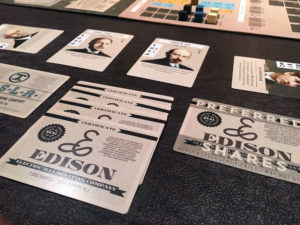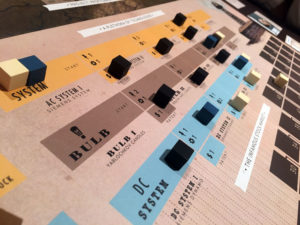 My home state of New Jersey was the site of one of the greatest feuds in history, and I am not talking about Hamilton and Burr. Thomas Edison and Nikola Tesla set up competing electric companies practically down the road from each other, working to achieve supremacy in the burgeoning power and light industry. Based on the number of public schools here named after Edison, it is clear who was victorious those years ago.
My home state of New Jersey was the site of one of the greatest feuds in history, and I am not talking about Hamilton and Burr. Thomas Edison and Nikola Tesla set up competing electric companies practically down the road from each other, working to achieve supremacy in the burgeoning power and light industry. Based on the number of public schools here named after Edison, it is clear who was victorious those years ago.
Tesla vs. Edison: War of Currents puts you back into that battle for the future of the electrical age, while possibly providing a different outcome than history recorded. Does Tesla vs. Edison turn the power dial to maximum, or does all the circuitry overload? Continue reading to find out!
Tesla vs. Edison: War of Currents is a stock market and resource management game for 2-5 players that takes about 60-90 minutes to play. This game plays best with 3 or 4 players.
Gameplay Overview:
At the beginning of Tesla vs. Edison (TvE), each player starts by selecting a primary inventor who comes with stock shares in their respective companies, possessing varied ratings in invention, manufacturing, finance, and propaganda, and a variable gameplay power. These inventors are the eponymous Tesla and Edison, as well as other notable inventors.
The game spans six turns, which are divided into three phases of two turns each. Luminaries, historical figures and scientists of the time, are auctioned off at the beginning of each phase. Each luminary has ratings and powers similar to the inventors, and comes with a random share of stock and auctions are held until each player purchases a luminary.

During each turn, a player exhausts their inventors and luminaries in order to perform one of the following actions:
- Advance a technology: Move up the track in AC, DC, or light bulb tech by luminaries with invention and manufacturing ratings equal to the requirements for each tech level. Players can also purchase patents while moving up the tech tracks, requiring other players to pay the patent holder when that tech is used to claim projects.
- Claim a project: Powering a city requires advancement on the tech track, and monetary investment based on a combination of luminary finance rating, the location, and size of the project impacting the cost and eventual benefit.
- Engage in propaganda: Propaganda cards can be activated that affect turn order and move public opinion in favor of AC or DC power, which has an impact on stock prices and project impact.
- Visit the stock market: Buying and selling stocks is how you make money and control which player is in the lead, by changing the value of the stock based on how many shares were bought and sold.
At the end of the turn, the player order is changed based on any propaganda, stock prices are changed based on whether AC or DC power is more popular via the fame track, and each player receives money based on their company’s stock value. After 6 turns, the player with the most valuable stock portfolio is declared the winner.

Game Experience:
Tesla vs. Edison crams quite a bit of game into six rounds. Players are rather limited in their action selection, especially the first two rounds, choosing actions carefully and strategically is of vital concern, as there is quite a bit to get done and not enough actions to do everything. Identifying your goals and working towards them is extremely important in the early game, but the game also allows you to change your goals and adapt mid-play. It is worth noting that this game can be prone to a fair bit of analysis paralysis, especially in the endgame where players are strategizing their stock buys and sells in order to maximize their portfolio value.
On the topic of the stock market, it is important to remember that this is a stock game first, and all the other mechanisms and gameplay serve to support that. In our first few plays, we found ourselves focusing more on technology and project development early on to get capital, then playing the stock game at the later rounds. We did not have a player solely focus on stock market at the expense of all other actions, as we collectively decided that sounded boring to play that way. However, your mileage (and player group) may vary.

The game brings together a variety of mechanisms, but the luminary auction was especially fun at the start of each phase. It required players to decide which luminary and respective stats were most beneficial for their long-term strategy. Each luminary in later phases also came with a random stock certificate, adding another layer to the decision-making and bidding. However, one of the issues encountered was that the luminaries with strong financial bonuses were far more powerful in the endgame, since their powers allowed players to get discounts on buying stock and bonuses when selling. They were not game-breaking, but gave a noticeable advantage to the players who had purchased them.
Our favorite part of Tesla vs. Edison was the technology development and the building and claiming of projects. While the game win condition is solely on the stock market, we enjoyed the engine-building that had to be engaged in order to develop the capital to start playing the market. While we understand the design considerations, we hoped that the project and tech development counted more in the endgame to determine player victory.
One of our criteria for a successful game is an immersive theme, and Tesla vs. Edison delivered in a big way. Between the different scientists and historical figures as luminaries, the propaganda cards that were based on historical events and the overall look and feel of the graphic design, fits the theme nicely. We found that the gameplay was immersive in the cutthroat time, giving us the chance to have agents spread rumors and misinformation, damage and attack manufacturing facilities (allegedly, of course), and work to give our company supremacy in the War of Currents.

One of the issues we encountered was that there was quite a bit of math involved when calculating all the monetary modifiers for a particular action. For instance, when completing a project, there were discounts for financial score that were multiplied by the game phase, penalties for space between established projects that were also multiplied by game phase, and payments to other players if they held patents in technology used. We were fortunate to have strong mathematical minds playing, but a card-sized player aid for each player provided in the box would have been helpful when trying to consider all the modifiers to an action.
Playing Tesla vs. Edison with two players was not very engaging, which was not a surprise since, in our experience, stock market and auction mechanics do not play well at that count. On the other hand, 5 players could be far too many due to downtime considerations combined with the potential for analysis paralysis. Three or four players seemed to be the sweet spot for Tesla vs. Edison.
Final Thoughts:
Tesla vs. Edison provides a complicated game with strategic decision-making, mathematical complexity and a little bit of analysis-paralysis that can be played in about an hour. Its tight design forces players to choose their actions carefully, and make the players have to decide where their priorities lie. The well-designed rules makes it easy to get into the game, with a minimum of explanation really needed for each action selection.
Tesla vs Edison is a game that is more enjoyable the more you play, allowing you to grasp the strategy and timing of when to perform particular actions. However, as well-designed as Tesla vs Edison is, we hoped for a little less emphasis on the stock market and more credence given to the other aspects of the game which we found more enjoyable.
Score: 3.5. A solid game that is full of tough decisions and a great theme, but a little too much emphasis on stocks for our tastes.
 Hits:
Hits:
• Theme is apparent both in gameplay and design
• Complex game for such a short play time
• Rules are easy to explain and comprehend
Misses:
• Too much emphasis on the stock market for the win condition.
• Needs a player aid for all the multipliers and modifiers to actions.






















Solid review.
Thanks, Tahsin. If there wasn’t as much of an emphasis on the stocks, I’d probably have rated this higher.
I find it odd to ding a stock market game for being too focused on the stock market.
Sure, TvE uses engine-building and resource management (it’s not Acquire, after all), but as you so aptly stated in the beginning, it is first and foremost a stock market game.
Considering your review, I suppose it depends on the original point of view: Applaud the game for doing all the other stuff well in addition to the stock market, or penalizing it for doing the stock market really well but not enough of the other stuff. The latter, however, implies false advertising, which TvE doesn’t actually do.
The review itself, I felt, is well-written and mostly does the game justice. The conclusion, however, misses the point.
Thanks for the comment!
You can literally do nothing but flip stocks and ignore your tech tree and projects and win the game. That, to me, is a detriment to my enjoyment of the game, especially since the projects and tech are the aspects I find interesting and appealing.
The expansion has apparently fixed some of these issues, from my understanding, but I cannot say for certain as I have not played it.
I get what you’re saying, although I haven’t actually seen anyone winning the game that easily. The counterpoint to that being that it would be possible for the other players to basically lock out a pure stock market player from the most lucrative stocks as soon as they home in on the fact that that’s what the player in question is doing.
Although TvE is more complicated, the stock market part functions along similar lines as Acquire, and there as well, it is possible to lock a player out who focuses too much on a single stock.
However, I concede that as I stated in the beginning, I haven’t yet seen a player try this approach.
Are there “better” games than TvE? Definitely. Are there “better” stock market games? The aforementioned Acquire still holds a special place in my heart, probably due to the fact that it was my first game of this kind. I’ve since played a few others and never quite took fancy with stock market games in general, but there are different iterations that, like different worker placement games, approach the theme from different angles. TvE doesn’t do too badly in comparison, I think.